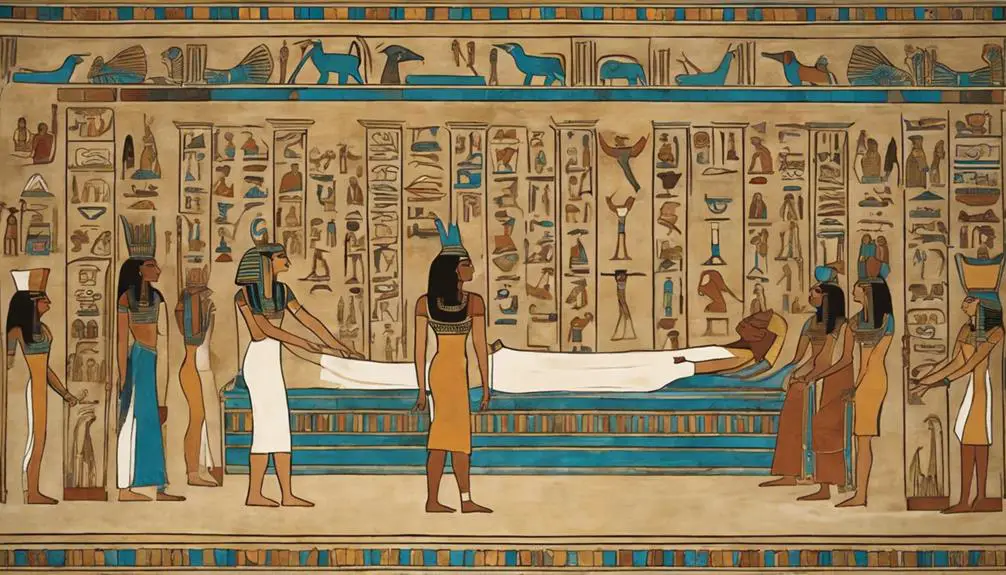Origins of Hypnosis Timeline
Significance of Hypnosis in Historical Cultural Contexts
June 21, 2017 - Origins of Hypnosis Timeline
Within ancient Mesopotamia, Greece, Egypt, Hinduism, and shamanic practices, hypnosis held a pivotal role. Trance-like states induced through rituals and spiritual beliefs emphasized mind-body-spirit connection for healing. Greek temples dedicated to healing gods facilitated cures through divine dreams and holistic rituals. Egyptian sleep temples utilized sleep-like states for therapy and dream interpretation. Hindu yogic traditions focused on altered consciousness through meditation for enlightenment. Shamans bridged the physical and spiritual realms to restore balance and heal ailments. These rich historical cultural contexts set the stage for modern therapeutic applications of hypnosis, blending spirituality and holistic healing practices.
Ancient Mesopotamian Practices

Ancient Mesopotamian practices involving hypnosis demonstrate a complex interplay between spiritual beliefs and healing rituals, offering valuable insights into the early cultural perceptions of altered states of consciousness.
Mesopotamian rituals often incorporated trance-like states induced through repetitive chanting, rhythmic drumming, and sensory deprivation to access the spiritual realm for healing purposes. These trance states were believed to facilitate communication with deities or spirits to diagnose and treat ailments.
In Mesopotamia, healing practices were deeply intertwined with religious beliefs, with healers acting as intermediaries between the physical and spiritual worlds. The ancient Mesopotamians viewed illnesses as manifestations of spiritual disharmony, and through hypnosis-induced trances, healers aimed to restore balance by addressing underlying spiritual causes.
This holistic approach to healing highlights the interconnectedness of the mind, body, and spirit in Mesopotamian culture. By delving into these ancient healing practices, we gain a deeper understanding of how early civilizations perceived the power of altered states of consciousness in promoting health and well-being.
Greek Temples and Healing
Greek sanctuaries, particularly those dedicated to healing gods like Asclepius, were pivotal centers for therapeutic practices in ancient Greece. These temples were not only places of worship but also sites where individuals sought healing through a combination of physical, psychological, and spiritual methods. Temple practices often involved rituals such as purification, sacrifices, and dream interpretation. Patients would come to the temples seeking cures for various ailments, and it was believed that the gods would reveal the necessary remedies through dreams or visions.
Healing rituals conducted in these temples were elaborate and multifaceted. They included activities like bathing, offering prayers, and sleeping within the sacred precincts. The incubation process, where patients slept in the temple in hopes of receiving divine guidance or healing through dreams, was a common practice.
The priests and priestesses of Asclepius played a crucial role in facilitating these rituals and interpreting the messages from the gods. Overall, Greek temples dedicated to healing were integral to the ancient healthcare system, blending spirituality, medicine, and psychological well-being in a holistic approach to healing.
Egyptian Sleep Temples

Drawing parallels to the healing sanctuaries of ancient Greece, the Egyptian Sleep Temples also held significant cultural and therapeutic importance in ancient Egyptian society. These temples were dedicated to the god Imhotep, who was believed to be a healer and the patron of medicine. Temple rituals in these sanctuaries often involved inducing a sleep-like state in patients through the use of hypnotic suggestion, fragrances, and soothing sounds.
Healing practices in the Egyptian Sleep Temples focused on interpreting dreams as a means of diagnosing and treating illnesses. Patients would sleep in the temple overnight, and priests, who were trained in the art of dream analysis, would interpret their dreams in the morning to prescribe treatments or cures.
This form of therapy was a precursor to modern-day hypnosis techniques and demonstrates the deep understanding that the ancient Egyptians had of the mind-body connection in healing. The Egyptian Sleep Temples served as centers of both physical and psychological healing, showcasing the sophisticated medical knowledge and spiritual beliefs of ancient Egyptian civilization.
Hindu Yogic Trance
In the practice of Hindu Yogic Trance, individuals enter altered states of consciousness through deep meditation and focused breathing techniques. Yogic meditation, a fundamental aspect of Hindu spiritual practices, involves a disciplined approach to calming the mind and focusing on inner awareness. Through this process, practitioners aim to transcend the limitations of the physical body and connect with higher states of consciousness.
Altered consciousness in Hindu Yogic Trance is not seen as an escape from reality but rather as a pathway to deeper self-awareness and spiritual enlightenment. By quieting the fluctuations of the mind, individuals seek to explore the depths of their inner being and tap into universal truths beyond the material world. This altered state is believed to open channels to profound insights, self-realization, and a heightened sense of interconnectedness with the cosmos.
Through the centuries, Hindu Yogic Trance has been a central practice in various Indian spiritual traditions, offering a transformative journey towards self-discovery and transcendence.
Shamanic Rituals and Trance

Shamanic rituals encompass a diverse range of practices across various cultures, often involving trance states to facilitate communication with the spiritual realm. These rituals are deeply rooted in tribal ceremonies and are central to the spiritual healing practices of indigenous cultures worldwide. Shamanic practitioners, known as shamans, enter altered states of consciousness through techniques such as drumming, chanting, and dancing to connect with the spirit world.
Within indigenous communities, shamans play a vital role as mediators between the physical and spiritual realms. They are revered for their ability to heal the sick, communicate with ancestors, and provide guidance in times of crisis. The trance state induced during shamanic rituals is believed to allow the shaman to access hidden knowledge, divine the future, and restore balance within the individual and the community.
The significance of shamanic rituals and trance lies not only in their cultural importance but also in their therapeutic potential for addressing spiritual, emotional, and physical ailments within indigenous societies.
Medieval European Witch Trials
Throughout medieval Europe, the witch trials were a series of legal proceedings that targeted individuals, primarily women, accused of practicing witchcraft. These trials, prevalent between the 15th and 18th centuries, were fueled by widespread witchcraft accusations and religious persecution. The accusations often stemmed from societal fears, superstitions, and political motivations, leading to the persecution of thousands of individuals across Europe.
The witch trials were characterized by harsh interrogation methods, including torture, to extract confessions from the accused. Once labeled as witches, individuals faced severe punishments, including imprisonment, banishment, and even execution. The trials were often orchestrated by ecclesiastical and secular authorities, with the Church playing a significant role in promoting the idea of witchcraft as heresy.
The witch trials not only reflected the prevailing attitudes towards witchcraft during the medieval period but also highlighted the deep-rooted fears and prejudices present in society. The legacy of these trials continues to serve as a dark reminder of the dangers of mass hysteria and religious extremism.
19th Century Hypnotism Studies

Within the context of the 19th century, studies on hypnotism emerged as a subject of increasing interest and exploration. Pioneering figures like James Braid and Jean-Martin Charcot played crucial roles in shaping the understanding of hypnotism during this period. Braid, a Scottish surgeon, introduced the term 'hypnotism' and emphasized its therapeutic potential, laying the groundwork for modern applications in psychology and medicine.
In the 19th century, scientific research on hypnotism focused on unraveling its mechanisms and applications. Scholars delved into the therapeutic benefits of hypnosis, uncovering its potential for treating various psychological and physiological conditions. Moreover, hypnotism studies during this era provided valuable psychological insights into the nature of consciousness and suggestibility.
The legacy of 19th-century hypnotism studies continues to influence contemporary understandings of hypnosis. Today, hypnotherapy is recognized as a legitimate form of treatment, with ongoing research exploring its efficacy in addressing issues such as chronic pain, anxiety, and addiction. The foundational work of 19th-century scholars has paved the way for the integration of hypnosis into modern therapeutic practices.
Frequently Asked Questions
How Did Hypnosis Evolve Over Time in Different Cultures?
Cross-cultural comparisons reveal diverse evolutionary practices of hypnosis over time. Different cultures have adapted and integrated hypnosis into traditional healing methods, spiritual rituals, and psychological therapies. This evolution showcases the versatility and significance of hypnosis globally.
Were There Any Ethical Concerns Related to Hypnotic Practices?
Ethical considerations surrounding hypnotic practices have been a subject of debate due to concerns about consent, manipulation, and potential psychological harm. Cultural implications also play a role in shaping perspectives on the ethical use of hypnosis.
What Materials or Tools Were Used During Hypnotic Rituals?
During hypnotic rituals, ritual objects like crystals, feathers, and drums were used to induce trance states. In shamanic practices of ancient civilizations, these tools were essential in guiding individuals into altered states for healing and spiritual exploration.
How Did Societal Beliefs Influence the Perception of Hypnosis?
Societal beliefs, deeply rooted in cultural influences, shaped perceptions of hypnosis. Varied interpretations range from mystical powers to psychological tools. Understanding these societal constructs is crucial in exploring the multifaceted nature of hypnosis across different historical periods and cultural contexts.
Were There Any Famous Historical Figures Known for Practicing Hypnosis?
Hypnosis pioneers like Franz Mesmer and James Braid are renowned for their contributions to historical hypnosis practices. Their work laid the foundation for modern understanding and utilization of hypnosis, shaping its evolution in various fields.
Conclusion
Overall, the historical cultural contexts of hypnosis reveal a fascinating intersection of spirituality, healing practices, and societal norms.
From ancient Mesopotamian rituals to Greek temples and Egyptian sleep temples, hypnosis has been utilized for centuries in various cultures around the world.
The significance of hypnosis in these contexts highlights the importance of altered states of consciousness in human history and the enduring impact of trance-like practices on cultural beliefs and traditions.
